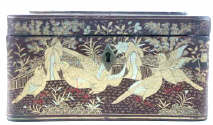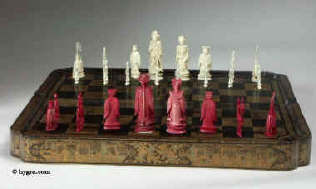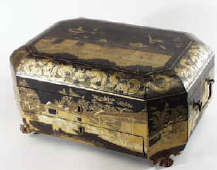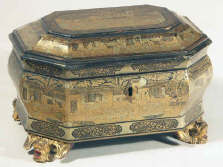GATHERING AND PREPARING
Oriental Lacquer is the natural sap of trees belonging to the
Rhus species. It was first used in China both to protect and
beautify wood. There are references to Emperor Shun (2255-2205BC)
the last of the five sages advocating its use to his people. It
is impossible to determine the precise date of its first
application; it is part of an ancient and revered tradition
interlinked with the culture of this complex ancient civilization.
The tree, which yields the best lacquer, is the Rhus
Vernicifera, which is indigenous to China. At first the trees
grew wild but as their value was understood they were cultivated
and periodically protected by law.
The trees yield the best sap when they are a few years old.
Depending on weather and soil conditions they can be ready in
five years and continue to yield good lacquer until they are ten.
The best time for gathering the sap is during the warmer months
of the year when the trees are more active growing and the liquid
flows and rises in greater quantities. It also oozes more freely
without the cold freezing it. The trees are mostly found on high
ground, above six and a half thousand feet where temperatures are
very low in winter. In earlier times, before the plains were
cleared for agriculture Rhus trees were also grown on lower
ground.
A Chinese export lacquer tea caddy in reddish earth colored lacquer having rounded corners decorated with two colors of gold depicting groups of birds highlighted in red lacquer. Circa 1840
|

|
The sap is gathered by incising the trees horizontally and
allowing it to trickle into cup shaped containers of copper or
bamboo, which are tied underneath. When the sap first comes out
it is dirty white, somewhat like a grayish mushroom. When it is
exposed to light and air it thickens and darkens.
The preparation of the sap is a long and laborious process. At
first it is strained to remove the impurities such as fragments
of wood and insects which may have gathered in the containers.
Then the sap is heated in shallow containers. Throughout the
“cooking” process it is stirred and skimmed so it
gradually becomes more pure and even. Finally it is filtered
through cloth to make sure that even tiny particles of foreign
matter are removed. Once the sap has been turned to lacquer it is
stored in airtight containers where it can be kept for years.
Inferior lacquer can be extracted from the smaller branches of
the trees by boiling them in hot water and then allowing the
water to evaporate. The lacquer is cleared of impurities and it
is used for undercoating.
APPLYING
Once the lacquer was prepared an even more painstaking and time
consuming process was needed to successfully use it for coating
whatever surface was to be lacquered.
The main quality of lacquer is that it provides a hard
surface, which is impervious to insects, acids, water and other
natural and man inflicted attacks. However for the lacquer to
harden evenly, care and skill as well as vigilance must not
slacken for one second. The chemical process, which combines the
elements within the sap and enables the final product to harden
must be carried in strictly controlled conditions. The
temperature must be between 25-30 degrees Centigrade and the
humidity as high as 80%-85%.
Oxygen is necessary for the process to be successful and
humidity ensures that it is easily and evenly absorbed. Added to
this, a humid atmosphere ensures that the lacquer dries evenly
without the uppermost layer, however thin, drying faster and
trapping damp bubbles. Workshops for drying lacquer
were often set up near rivers. Wooden small chambers for drying
objects would be kept damp by keeping them moist. Vapour baths
were also another technique for increasing humidity.
The base of objects, in our case boxes, to be coated was
constructed out of softwoods. The pieces of wood had to be
selected so that they had no knots. This is because the resin,
which the knotty parts of timber excrete, can seep into the
lacquer and spoil the hardening process.
Once the base was made it was primed in inferior lacquer. On
some boxes a thin muslin type cloth was also used to cover the
base. This was held in place with vegetable glue or lacquer,
sometimes mixed with rice paste. Looking at cross sections of
damaged boxes it is obvious that different workshops employed
different techniques. The main purpose however was always the
same: to seal the wood completely before the final more
decorative layers were to be applied. The wood sap was thus
completely isolated from the final surface.
When the box was primed it was smoothed down with ground stone
or clay so that it was as even as possible before the more
precise and arduous application of the top layers began. At this
stage the required pigment was added to the lacquer. The lacquer
was then applied in very thin coats and allowed to dry for three
days or more if necessary, until it became completely hard. It
was then rubbed smooth with clay or charcoal dust. Several layers
were built up until a completely smooth and even surface was
achieved. The final coats were rubbed with deer horn ash, which
was the finest form of abrasive.
Again looking at cross sections of damaged boxes it is obvious
that different craftsmen favored different techniques. The color of the undercoats is sometimes whitish, sometimes brown
and sometimes grayish. This must be because the undercoating
lacquer was sometimes mixed with clay, sometimes with fine ash
and sometimes with rice flour in different combinations. All
these techniques were traditionally used for thousands of years.
It could take up to thirty coats of applied lacquer, starting
with undercoats grading up to finer coats before a box was ready
for decoration. It would then move on to the “artist”
having gone through the hands of the cabinetmaker who made the
wooden base and the lacquerer who prepared it.
DECORATION
Lacquer has always been revered in China as one of the great
arts, which combine special materials with the uttermost skill
and design flair. Prized throughout the centuries above gold, it
reflects the civilisation that developed it, in that it is a
patient and meditative process requiring a variety of structured
disciplines and intellectual input.
Perceived as such a special reflection of the country’s
culture, it is not surprising that the art of lacquer decoration
was a constant striving towards perfection. This art took many
and varied forms throughout the four thousand years or so of its
known existence.
Archaeological evidence points to lacquer first used as a
protective coating and by the second millennium BC as an in-fill
in bronze incised objects, or adhesive for precious metals or
stones.
Carved objects made out of multi layered built lacquer have
been made at various periods and are still made to day albeit the
fact that new techniques have made the work simpler and the
quality inferior.
19th c. Chinese Export Lacquer with ivory Chess, Drafts, and Backgammon pieces
|

|
Shallower carving on its own or in conjunction with other
techniques has also been used from time to time.
Gold leaf, gold lines, painting in colors or gold were used
since the first millennium BC and continued to be used until the
end of the 19th century. Commercial versions are still employed
today with the sporadic attempt at traditional methods, which are
no longer financially viable.
PAINTING ON LACQUER BOXES made for
EXPORT
The boxes we are concerned with which were made in the late 18th
and up to the late 19th century, continue the tradition of
painting, predominantly in gold on a black and very occasionally
red background.
Painting on flat surface lacquer was found on objects, which
date from the Han Dynasty (206BC-221AD). Although gold was used
it was more as gold leaf inlay with the painting done in other colors such as black and gold, the pigments mixed with lacquer.
Different ways of employing gold leaf or lines were used in
lacquer decoration throughout the centuries. However the origins
of gold painting as seen on the boxes we are discussing here date
from the fifteenth century AD. The art of lacquer was introduced
to Japan by Chinese craftsmen, who also introduced the art of
incising lacquer and enhancing it with gold lines.
Fitted Chinese Export Lacquer Sewing Box decorated with Tea Cultivation Scenes, circa 1830
This particular box is painted exceptionally well,
with a robustness of line, with attention to minutiae, and with skillful
use of bright gold contrasted against black expanses.
|
 |
The Japanese were most impressed by lacquer as an art medium
and by the use of gold in its decoration. When more gold reserves
were found in Japan the Japanese artists perfected the craft of
powdering gold very finely and mixing it with lacquer, making it
possible to paint or build layers of gold dust and lacquer on the
pre prepared surfaces.
Craftsmen from both countries were sent back and forth to
learn from each other. A renowned Chinese lacquerer, Yang Xuan is
said to have gone to Japan to learn the new gold techniques from
the Japanese early in the fifteenth century AD. He not only learned
but also invented a technique of incising and in filling lacquer
with gold which impressed his teachers.
During the four centuries following this visit there was a lot
of cross-pollination between the two cultures as regards lacquer
decoration. The sprinkled gold and other metal dust technique,
which is associated with Japanese work, is also found to a much
lesser degree on Chinese objects. Although the decorative styles
are on the whole distinguishable, there are overlaps to the
extent of confusion.
Finally there are the oriental symbols and motifs which are
found on lacquer throughout the far east, such as dragons, vases,
insects, diaper patterns to denote water, air and earth, as well
as stylised borders of Greek key designs etc. It is not always
certain where each design originated from, although China with
its history of early cosmopolitan trading was usually the first
oriental country to add to the repertory of lacquer decoration.
Chinese artists absorbed and translated designs from different
traditions giving them a unique oriental flavor. These imported
influences were added to the art which had its roots deep in
Chinese culture to create the spectacularly beautiful export
boxes which encapsulate that particular moment in history when
the East truly met the West.
EXPORT LACQUER BOXES late 18th Century
to 1820
By the end of the eighteenth century the East India Company had
its feet well ensconced in Chinese soil. (See
Tea and Opium). Near the warehouses of this Company and other
European and American company headquarters a small trading
community sprang up trading not only in commodities such as tea
and spices, but also in an unprecedented

wealth of eclectic
goods, such as silk, porcelain, paintings and of course lacquer.
Most of these artistic outlets were in China Street, which was
within easy reach of the foreign traders.
The first boxes in what we now call ‘export lacquer’
to be made were commissioned by the foreign traders or diplomats
for their own use. These are of very high quality and often bear
family crests or initials. Such a box included in the 1774
inventory of the Clive collection at Powis Castle combines
several characteristics of the period. The overall design is that
of plants with the crest in the centre.
The early boxes have several features, which betray their
European destination. They were made to be used for the needs of
the Europeans or Americans. They were mostly card boxes, sewing
boxes and tea caddies. They were of the type, which in other
countries were made mostly in wood.
The decoration was of floral designs, borders of linear
patterns and cartouches filled in with crests, monograms or
simply alternative flora or shapes. There is a definite influence
of decorative conventions, which were fashionable in England at
the end of the eighteenth century. These originated from the fad
for the classical world, which was being revealed through the
numerous excavations and extensive travelling of those who wished
to be better informed.
Vines, ivy and other stylised flora were the order of the day.
Symmetrically arranged, these motifs were reminiscent of ancient
Rome although in raised gold lacquer they definitely acquired a
Chinese aura. A few boxes had flat painted decoration in other
colours. This was done by mixing different pigments with oil or
lacquer. Sometimes the stylized raised lacquer was juxtaposed
with a cartouche, or an alternative line of flat painting.
Zig zag designs with alternative bands of decoration sometimes
one flat one in relief were also made. More than one color of
gold with sometimes a little red or blue was used for subtle
differentiation.
Some early lacquer boxes have an overall effect of very
opulent brocade with mounts of gold covering most of the black
surface. Such boxes must have been decorated by very experienced
and serene artists. They represent months of immaculate work,
which was only possible after years of training.
Other early boxes look as if they were painted with the
lightest of brush strokes in the most ethereal subtle colors.
The shapes of the early boxes are restrained. They are mostly
rectangular with flat tops and flat sides. The interior contents
reflect their use.
GAME boxes contained smaller boxes for playing cards and
gaming counters. Some also contained trays which were stacked on
top of each other when not in use. In the earliest examples the
trays were decorated in a similar way to the main box and the
smaller interior boxes.
SEWING boxes had a top compartment with a lift out tray, which
contained ivory sewing tools. The tools were in shapes similar to
their English counterparts. There was a drawer, which pulled out
from the front of the box, which had a lift up drawing surface
and small compartments. Sometimes there were small china dishes
for use when painting on silk.
TEA CADDIES contained pewter canisters with a double lid.
These were decorated with incised designs.
| Chinese export lacquer tea chest with scenes of tea trading the interior fitted with metal canisters, circa 1840 |
 |
19th CENTURY EXPORT LACQUER BOXES
The type of boxes made in the nineteenth century is on the whole
the same as those made in the latter part of the eighteenth
century. There are however significant stylistic differences
which are very pronounced by the 1830s. On boxes made during the
early years of the century the differences are subtler, often
resulting in very pleasing cross-cultural effects.
Chinese export boxes were first made for foreigners who
commissioned work for their special needs. As in other forms of
such commissions, for example furniture or paintings, the person
ordering the item supplied designs and specifications. The
craftsmanship of the Chinese was admired, but the European eye
was too unaccustomed to Oriental art to accept it without a
degree of western mitigation. Thus the 18th century boxes have
tendrils which could have been copied from Pompeii and vines
which could have grown in Greece. These were combined with
lattice and abstract meandering designs, which were more
oriental, but these were subtle and unobtrusive.
However as the foreigners became more familiar with Chinese
art forms and the symbolism and culture expressed therein, the
balance began to shift. Whereas at first they were trying to tell
the Chinese what they wanted them to know and make, by the
nineteenth century they wanted the people back home to know what
the Chinese knew and made.
The vignettes within the elaborate borders began to have
paintings portraying Chinese courtly scenes. These were mostly of
figures in pavilioned gardens or in landscapes. Such figurative
paintings were already part of the long tradition of Chinese
lacquer decoration. Another type of early 19th century decoration
within a cartouche was the depiction of an animal or bird in flat
paint usually in blue, grey and red. These creatures were stylized and glamorized
and harked back to lacquer paintings of
previous centuries.
By the 1820s the inter-trading was very robust and although
the foreigners were forbidden from living in the Chinese areas, a
lot of social intercourse had developed between the traders, the
diplomats and the Co Hong merchants. These merchants who were the
go-betweens allowed to trade with the ‘foreign devils’
amassed huge fortunes and kept impressive and beautiful
establishments where they occasionally entertained their foreign
colleagues.
Their fairy tale homes were constructed amongst wondrous
gardens in shapes and structures of unfamiliar curves and
pinnacles. These together with the visits to the botanical
gardens which the foreigners were allowed, must have opened up a
miraculous new world to people who came from societies which
adhered to strict classical rules and constricts. The Chinese
people too, floating in their rich silk robes must have looked
pretty spectacular. In short this was an exotic world, which
expanded one's understanding of beauty and culture and as, such
the traders wanted to share it with the people back home.
The artwork on the boxes began to depict more and more scenes
from Chinese life. Gardens, water, pavilions peopled with ladies,
sages, musicians, animals and birds. In a way the boxes became
like elaborate and precious postcards of the foreign land.
Sometimes complex scenes of festivals, battles, the processing of
tea, or the life of the harbour would be depicted on a box.
The earlier convention of painting within cartouches was still
used but the cartouches expanded to the point that they became
more like borders framing an important scene. The borders too
gradually changed from tendrils of flora to more oriental motifs
allowing for dragons, insects and more exotic plants.
The more complex scenes, especially the ones with freer
movements hardly had any borders. The designs on these are not
symmetrical but composed more like landscape paintings with the
picture sharply drawn in gold against the black lacquer.
As the century progressed and demand increased many boxes were
produced which although very attractive were not of the artistic
merit of the master decorated examples. The scenes and filled in
borders or cartouche surrounds became simpler. The decoration was
standardised and done by craftsmen copying typical scenes. This
was still time consuming and needed dedication, but it did not of
course need the enormous investment of time and intellectual
input of the special pieces.
